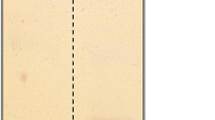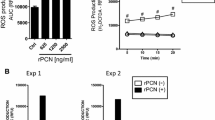Abstract
Binding of yeast forms to human lung fibroblast cultures was analyzed, aiming to better understand the initial steps of Paracoccidioides brasiliensis infection in humans. A significant P. brasiliensis adhesion was observed either to fibroblasts or to their Triton X-100 insoluble fraction, which contains extracellular matrix and membrane microdomains enriched in glycosphingolipids. Since human lung fibroblasts express at cell-surface gangliosides, such as GM1, GM2, and GM3, the role of these glycosphingolipids on P. brasiliensis adhesion was analyzed by different procedures. Anti-GM3 monoclonal antibody or cholera toxin subunit B (which binds specifically to GM1) reduced significantly fungal adhesion to fibroblast cells, by 35% and 33%, respectively. Direct binding of GM1 to yeast forms of P. brasiliensis was confirmed using cholera toxin subunit B conjugated to AlexaFluor®488. It was also demonstrated that P. brasiliensis binds to polystyrene plates coated with galactosylceramide, lactosylceramide, trihexosylceramide, GD3, GM1, GM3, and GD1a, suggesting that glycosphingolipids presenting residues of beta-galactose or neuraminic acid at non-reducing end may act as adhesion molecules for P. brasiliensis. Conversely, no binding was detected when plates were adsorbed with glycosphingolipids that contain terminal residue of beta-N-acetylgalactosamine, such as globoside (Gb4), GM2, and asialo-GM2. In human fibroblast (WI-38 cells), GM3 and GM1 are associated with membrane rafts, which remain insoluble after treatment with Triton X-100 at 4°C. Taken together, these results strongly suggest that lung fibroblast gangliosides, GM3 and GM1, are involved in binding and/or infection by P. brasiliensis.


Similar content being viewed by others
References
San-Blas G, Nino-Vega G. Paracoccidioides brasiliensis: chemical and molecular tools for research on cell walls, antifungals, diagnosis, taxonomy. Mycopathologia. 2008;165:183–95. doi:10.1007/s11046-007-9040-9.
Mendes-Giannini MJS, da Silva JLM, da Silva JD, Donofrio FC, Miranda ET, Andreotti PF, Soares CP. Interactions of Paracoccidioides brasiliensis with host cells: recent advances. Mycopathologia. 2008;165:237–48. doi:10.1007/s11046-007-9074-z.
Joh D, Wann ER, Kreikemeyer B, Speziale P, Hook M. Role of fibronectin-binding MSCRAMMs in bacterial adherence and entry into mammalian cells. Matrix Biol. 1999;18:211–23. doi:10.1016/S0945-053X(99)00025-6.
Lima OC, Figueiredo CC, Previato JO, Mendonca-Previato L, Morandi V, Bezerra LML. Involvement of fungal cell wall components in adhesion of Sporothrix schenckii to human fibronectin. Infect Immun. 2001;69:6874–80. doi:10.1128/IAI.69.11.6874-6880.2001.
Sundstrom P. Adhesins in Candida albicans. Curr Opin Microbiol. 1999;2:353–7. doi:10.1016/S1369-5274(99)80062-9.
Bouchara JP, Sanchez M, Chevailler A, MarotLeblond A, Lissitzky JC, Tronchin G, Chabasse D. Sialic acid-dependent recognition of laminin and fibrinogen by Aspergillus fumigatus conidia. Infect Immun. 1997;65:2717–24.
Klein BS. Molecular basis of pathogenicity in Blastomyces dermatitidis: the importance of adhesion. Curr Opin Microbiol. 2000;3:339–43. doi:10.1016/S1369-5274(00)00100-4.
Mendes-Giannini MJS, Soares CP, da Silva JLM, Andreotti PF. Interaction of pathogenic fungi with host cells: molecular and cellular approaches. FEMS Immunol Med Microbiol. 2005;45:383–94. doi:10.1016/j.femsim.2005.05.014.
Gonzalez A, Gomez BL, Diez S, Hernandez O, Restrepo A, Hamilton AJ et al. Purification and partial characterization of a Paracoccidioides brasiliensis protein with capacity to bind to extracellular matrix proteins. Infect Immun. 2005;73:2486–95. doi:10.1128/iai.73.4.2486-2495.2005.
Barbosa MS, Bao SN, Andreotti PF, de Faria FP, Felipe MSS, Feitosa LD, Mendes-Giannini MJS, Soares CMD. Glyceraldehyde-3-phosphate dehydrogenase of Paracoccidioides brasiliensis is a cell surface protein involved in fungal adhesion to extracellular matrix proteins and interaction with cells. Infect Immun. 2006;74:382–9. doi:10.1128/iai.74.1.382-389.2006.
Vicentini AP, Gesztesi JL, Franco MF, Desouza W, Demoraes JZ, Travassos LR, Lopes JD. Binding of Paracoccidioides brasiliensis to laminin through surface glycoprotein gp43 leads to enhancement of fungal pathogenesis. Infect Immun. 1994;62:1465–9.
Donofrio F, Calil A, Miranda E, Almeida A, Benard G, Soares C, Veloso S, Soares C, Mendes Giannini M. Enolase from Paracoccidioides brasiliensis: isolation and identification as a fibronectin-binding protein. J Med Microbiol. 2009;58:706–13. doi:10.1099/jmm.0.003830-0.706.
da Silva Neto B, de Fátima da Silva J, Mendes-Giannini M, Lenzi H, Almeida Soares C, Pereira M. The malate synthase of Paracoccidioides brasiliensis is a linked surface protein that behaves as an anchorless adhesin. BMC Microbiol. 2009;9:272. doi:10.1186/1471-2180-9-272.
Riethmuller J, Riehle A, Grassme H, Gulbins E. Membrane rafts in host-pathogen interactions. Biochim Biophys Acta. 2006;1758:2139–47. doi:10.1016/j.bbamem.2006.07.017.
Lafont F, van der Goot FG. Bacterial invasion via lipid rafts. Cell Microbiol. 2005;7:613–20. doi:10.1111/j.1462-5822.2005.00515.x.
Takahashi HK, Toledo MS, Suzuki E, Tagliari L, Straus AH. Current relevance of fungal and trypanosomatid glycolipids and sphingolipids: studies defining structures conspicuously absent in mammals. An Acad Bras Cienc. 2009;81:477–88. doi:10.1590/S0001-37652009000300012.
Fernandes MC, Cortez M, Yoneyama KAG, Straus AH, Yoshida N, Mortara RA. Novel strategy in Trypanosoma cruzi cell invasion: implication of cholesterol and host cell microdomains. Int J Parasitol. 2007;37:1431–41. doi:10.1016/j.ijpara.2007.04.025.
Krivan HC, Roberts DD, Ginsburg V. Many pulmonary pathogenic bacteria bind specifically to the carbohydrate sequence GalNAcβ1–4Gal found in some glycolipids. Proc Natl Acad Sci (USA). 1988;85:6157–61.
Hug P, Lin H, Korte T, Xiao X, Dimitrov D, Wang J, Puri A, Blumenthal R. Glycosphingolipids promote entry of a broad range of human immunodeficiency virus type 1 isolates into cell lines expressing CD4, CXCR4, and/or CCR5. J Virol. 2000;74:6377–85.
Maza PK, Straus AH, Toledo MS, Takahashi HK, Suzuki E. Interaction of epithelial cell membrane rafts with Paracoccidioides brasiliensis leads to fungal adhesion and Src-family kinase activation. Microb Infect. 2008;10:540–7. doi:10.1016/j.micinf.2008.02.004.
Jimenez-Lucho V, Ginsburg V, Krivan H. Cryptococcus neoformans, Candida albicans, and other fungi bind specifically to the glycosphingolipid lactosylceramide (Galβ1–4Glcβ1–1Cer), a possible adhesion receptor for yeasts. Infect Immun. 1990;58:2085–90.
Hakomori S. Chemistry of glycosphingolipids. In: Janfer JN, Hakomori S, editors. Sphingolipid biochemistry. New York and London: Plenum Press; 1983. p. 1–165.
Dohi T, Nores G, Hakomori S. An IgG3 monoclonal antibody established after immunization with GM3 lactone: immunochemical specificity and inhibition of melanoma cell growth in vitro and in vivo. Cancer Res. 1988;48:5680–5.
Straus AH, Levery SB, Jasiulionis MG, Salyan MEK, Steele SJ, Travassos LR, Hakomori SI, Takahashi HK. Stage-specific glycosphingolipids from amastigote forms of Leishmania (L.) amazonensis. Immunogenicity and role in parasite binding and invasion of macrophages. J Biol Chem. 1993;268:13723–30.
Okada Y, Mugnai G, Bremer E, Hakomori S. Glycosphingolipids in detergent-insoluble substrate attachment matrix (DISAM) prepared from substrate attachment material (SAM). Their possible role in regulating cell adhesion. Exp Cell Res. 1984;155:448–56. doi:10.1016/0014-4827(84)90205-2.
Torres B, McCrumb D, Smith D. Glycolipid-lectin interactions: reactivity of lectins from Helix pomatia, Wisteria floribunda, and Dolichos biflorus with glycolipids containing N-acetylgalactosamine. Arch Biochem Biophys. 1988;262:1–11. doi:10.1016/0003-9861(88)90161-0.
Carter W, Hakomori S. A new cell surface, detergent-insoluble glycoprotein matrix of human and hamster fibroblasts. The role of disulfide bonds in stabilization of the matrix. J Biol Chem. 1981;256:6953–60.
Hakomori S. Cell adhesion/recognition and signal transduction through glycosphingolipid microdomain. Glycoconj J. 2000;17:143–51. doi:10.1023/A:1026524820177.
Hakomori S. Bifunctional role of glycosphingolipids: modulators for transmembrane signaling and mediators for cellular interactions. J Biol Chem. 1990;265:18713–6.
Suzuki E, Tanaka AK, Toledo MS, Levery SB, Straus AH, Takahashi HK. Trypanosomatid and fungal glycolipids and sphingolipids as infectivity factors and potential targets for development of new therapeutic strategies. Bioch Biophys Acta. 2008;1780:362–9. doi:10.1016/j.bbagen.2007.09.009.
Gonzales A, Caro E, Munoz C, Restrepo A, Hamilton AJ, Cano LE. Paracoccidioides brasiliensis conidia recognize fibronectin and fibrinogen which participate in adherence to human type II alveolar cells: involvement of a specific adhesin. Microb Pathogen. 2008;358:389–401. doi:10.1016/j.micpath.2007.11.001.
Acknowledgments
This work was supported by Fundação de Amparo à Pesquisa do Estado de São Paulo (FAPESP), Conselho Nacional de Pesquisa (CNPq), and Coordenação de Aperfeiçoamento de Pessoal de Nível Superior (CAPES).
Author information
Authors and Affiliations
Corresponding author
Rights and permissions
About this article
Cite this article
Ywazaki, C.Y., Maza, P.K., Suzuki, E. et al. Role of Host Glycosphingolipids on Paracoccidioides brasiliensis Adhesion. Mycopathologia 171, 325–332 (2011). https://doi.org/10.1007/s11046-010-9376-4
Received:
Accepted:
Published:
Issue Date:
DOI: https://doi.org/10.1007/s11046-010-9376-4




